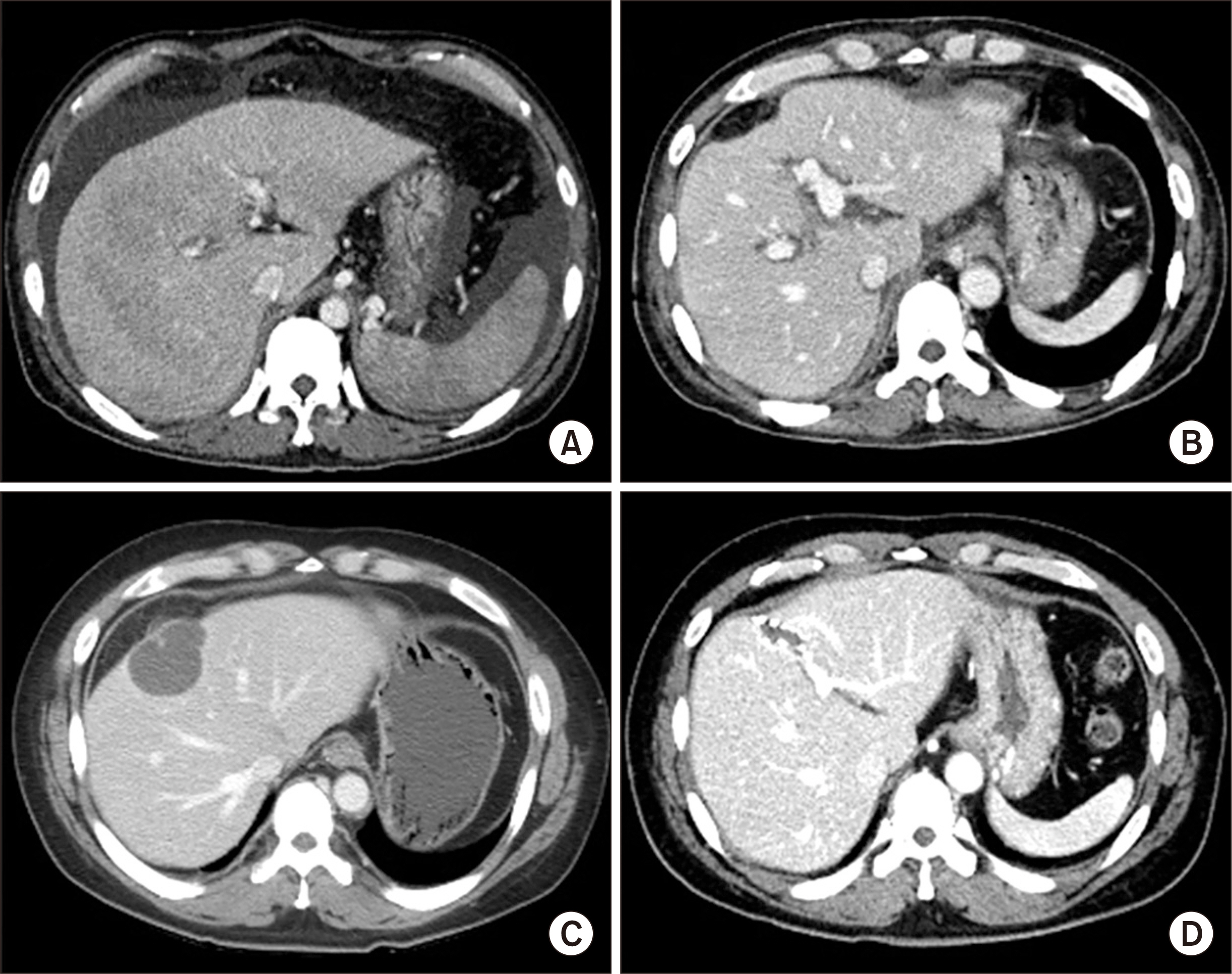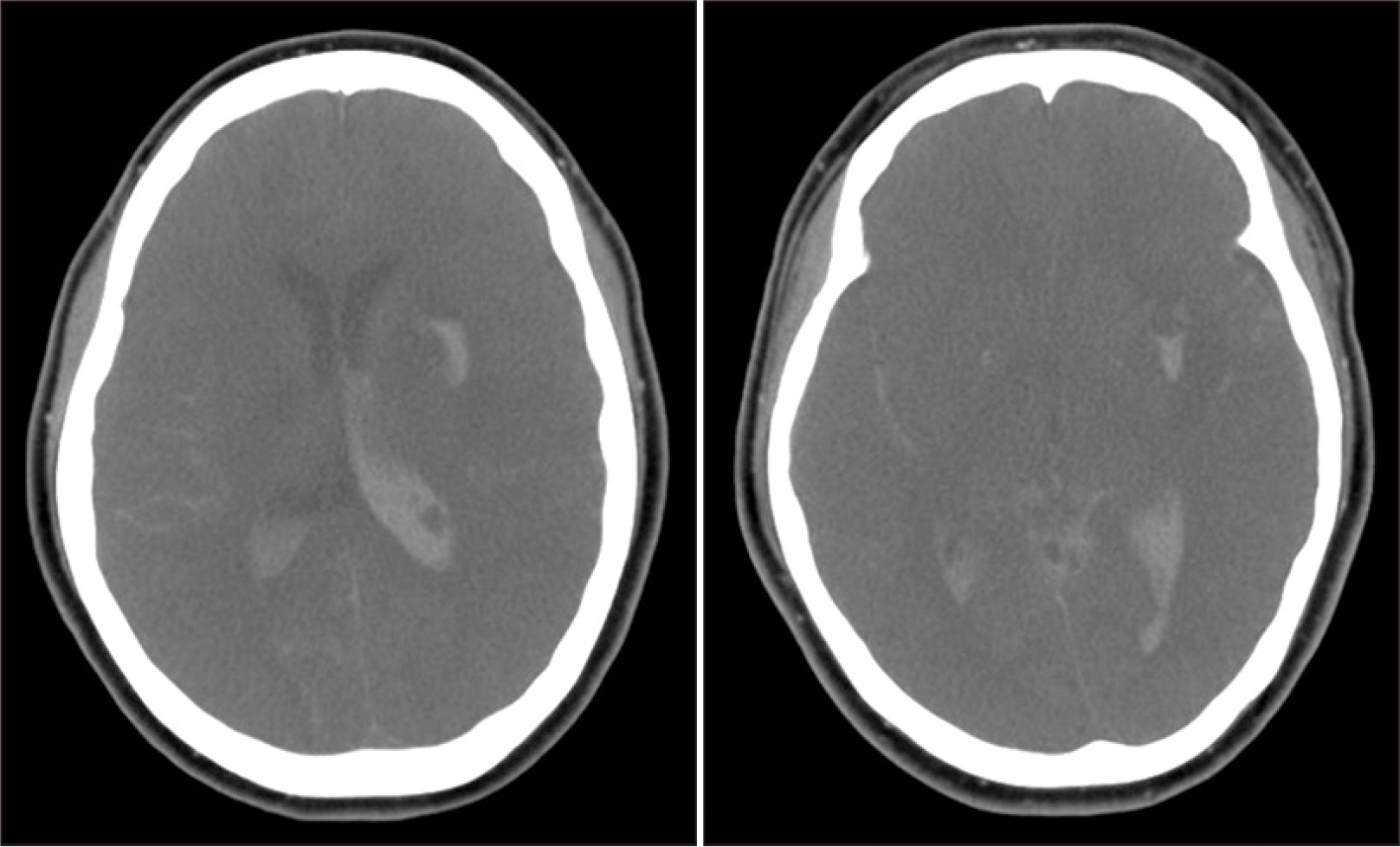Korean J Transplant.
2020 Dec;34(4):302-307. 10.4285/kjt.20.0028.
Liver transplantation from a non–heartbeating donor
- Affiliations
-
- 1Division of Hepatobiliary Surgery and Liver Transplantation, Department of Surgery, Asan Medical Center, University of Ulsan College of Medicine, Seoul, Korea
- 2Division of Acute Care Surgery, Department of Surgery, Asan Medical Center, University of Ulsan College of Medicine, Seoul, Korea
- KMID: 2510270
- DOI: http://doi.org/10.4285/kjt.20.0028
Abstract
- Interest in utilizing organs from non–heart-beating donors (NHBDs) has increased be-cause of the organ shortage. However, liver transplantation (LT) from NHBDs has been scarcely performed in Korea because only Maastricht category IV is legally permitted. We present one case of LT from an NHBD with extracorporeal membrane oxygenation (ECMO) support. The case was a 42-year-old male patient with alcoholic liver cirrhosis. The model for end-stage liver disease score was 28. The donor was a 47-year-old female who was diagnosed with brain death due to cerebral infarct, but cardiac arrest occurred before brain death was finally confirmed. Thus, venous-arterial type ECMO was initiat-ed for circulatory support. In the operating room, asystole developed just after ECMO was stopped. After waiting for 5 minutes, cardiac death was declared. It took 6 minutes from skin incision to aorta perfusion. The recipient hepatectomy and graft implantation were performed according to the standard procedures of adult whole LT. The patient recovered from LT uneventfully and has been doing well for 9 years after LT. The use of NHBDs is a method to increase the potential pool of organ donors, thus changes toward enhanced public awareness and acceptance of donating organs, and legal support at the government level are necessary.
Keyword
Figure
Reference
-
1. Busuttil RW, Tanaka K. 2003; The utility of marginal donors in liver transplantation. Liver Transpl. 9:651–63. DOI: 10.1053/jlts.2003.50105. PMID: 12827549.
Article2. Mackersie RC, Bronsther OL, Shackford SR. 1991; Organ procurement in patients with fatal head injuries: the fate of the potential donor. Ann Surg. 213:143–50. DOI: 10.1097/00000658-199102000-00009. PMID: 1992941. PMCID: PMC1358387.
Article3. White SA, Prasad KR. 2006; Liver transplantation from non-heart beating donors. BMJ. 332:376–7. DOI: 10.1136/bmj.332.7538.376. PMID: 16484243. PMCID: PMC1370960.
Article4. Foley DP, Fernandez LA, Leverson G, Chin LT, Krieger N, Cooper JT, et al. 2005; Donation after cardiac death: the University of Wisconsin experience with liver transplantation. Ann Surg. 242:724–31. DOI: 10.1097/01.sla.0000186178.07110.92. PMID: 16244547. PMCID: PMC1409855.5. Casavilla A, Ramirez C, Shapiro R, Nghiem D, Miracle K, Bronsther O, et al. 1995; Experience with liver and kidney allografts from non-heart-beating donors. Transplantation. 59:197–203. DOI: 10.1097/00007890-199501000-00008. PMID: 7839441. PMCID: PMC3035834.
Article6. Abt PL, Desai NM, Crawford MD, Forman LM, Markmann JW, Olthoff KM, et al. 2004; Survival following liver transplantation from non-heart-beating donors. Ann Surg. 239:87–92. DOI: 10.1097/01.sla.0000103063.82181.2c. PMID: 14685105. PMCID: PMC1356197.
Article7. Suh KS, Kim T, Kim J, Park YJ, Shin WY, Yi NJ, et al. 2009; Liver transplantation using non-heart beating donor: the first Korean case report. J Korean Soc Transplant. 23:77–80.8. Yu SK, Kim GS, Chung JY. 2010; Anesthesia for liver transplantation from a Maastricht category 4 non-heart-beating donor: a case report. Korean J Anesthesiol. 59 Suppl:S119–23. DOI: 10.4097/kjae.2010.59.S.S119. PMID: 21286419. PMCID: PMC3030015.
Article9. Park YM, Yang KH, Lee HY, Choi BH, Ryu JH, Chu CW. 2016; Irreversible graft failure requiring 3 repeated liver transplantations combined with a 2-stage liver transplantation: a case report. Transplant Proc. 48:242–6. DOI: 10.1016/j.transproceed.2015.11.011. PMID: 26915875.
Article10. Kootstra G, Daemen JH, Oomen AP. 1995; Categories of non-heart-beating donors. Transplant Proc. 27:2893–4. PMID: 7482956.11. Thuong M, Ruiz A, Evrard P, Kuiper M, Boffa C, Akhtar MZ, et al. 2016; New classification of donation after circulatory death donors definitions and terminology. Transpl Int. 29:749–59. DOI: 10.1111/tri.12776. PMID: 26991858.
Article12. Detry O, Le Dinh H, Noterdaeme T, De Roover A, Honoré P, Squifflet JP, et al. 2012; Categories of donation after cardiocirculatory death. Transplant Proc. 44:1189–95. DOI: 10.1016/j.transproceed.2012.05.001. PMID: 22663982.
Article13. Attia M, Silva MA, Mirza DF. 2008; The marginal liver donor: an update. Transpl Int. 21:713–24. DOI: 10.1111/j.1432-2277.2008.00696.x. PMID: 18492121.
Article14. D'Alessandro AM, Fernandez LA, Chin LT, Shames BD, Turgeon NA, Scott DL, et al. 2004; Donation after cardiac death: the University of Wisconsin experience. Ann Transplant. 9:68–71. DOI: 10.1097/01.sla.0000186178.07110.92. PMID: 16244547. PMCID: PMC1409855.15. Min SI, Ahn C, Han DJ, Kim SI, Chung SY, Lee SK, et al. 2015; To achieve national self-sufficiency: recent progresses in deceased donation in Korea. Transplantation. 99:765–70. DOI: 10.1097/TP.0000000000000412. PMID: 25226175.
- Full Text Links
- Actions
-
Cited
- CITED
-
- Close
- Share
- Similar articles
-
- Left at right heterotopic implantation of left liver graft in adult-to-adult living donor liver transplantation: the technical concern for decision-making
- Biliary Complications after Living Donor Liver Transplantation Differ from Those after Deceased Donor Liver Transplantation
- Liver retransplantation for adult recipients
- Unilateral Versus Bilateral Biliary Drainage for Post-Transplant Anastomotic Stricture
- Anatomical limits in living donor liver transplantation





